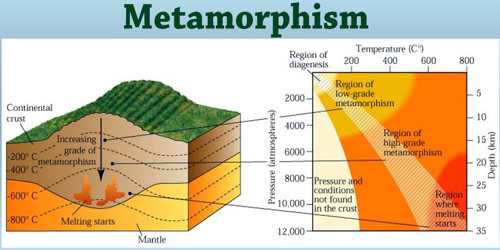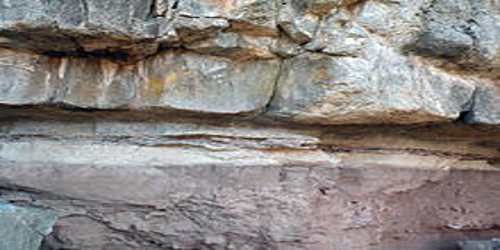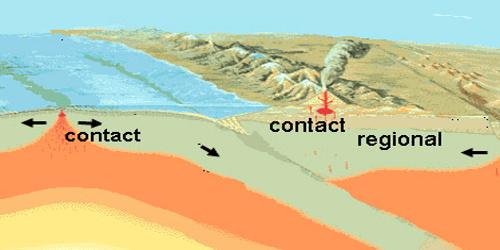Metamorphism
Definition
Metamorphism is the process by which rocks are changed in composition, texture, or structure by extreme heat and pressure. The change occurs primarily due to heat, pressure, and the introduction of chemically active fluids. The chemical components and crystal structures of the minerals making up the rock may change even though the rock remains a solid. Metamorphism typically occurs between diagenesis (max. 200°C), and melting (~850°C).

In prograde metamorphism metamorphic rocks that were formed under low pressure and temperature conditions undergo a second metamorphic event in which they are exposed to higher pressures and temperatures.
In retrograde metamorphism metamorphic rocks that were formed under high pressure and temperature conditions undergo a second metamorphic event in which they are exposed to lower pressures and temperatures.
Metamorphic rocks can change without melting. Heat causes atomic bonds to break, and the atoms move and form new bonds with other atoms, creating new minerals with different chemical components or crystalline structures (neocrystallization), or enabling recrystallization. When pressure is applied, somewhat flattened grains that orient in the same direction have a more stable configuration.

Occurrences and Types of Metamorphism
The word “Metamorphism” comes from the Greek: Meta = after, morph = form, so metamorphism means the after form. In geology this refers to the changes in mineral assemblage and texture that result from subjecting a rock to conditions such pressures, temperatures, and chemical environments different from those under which the rock originally formed. Metamorphism therefore occurs at temperatures and pressures higher than 200oC and 300 MPa. Rocks can be subjected to these higher temperatures and pressures as they are buried deeper in the Earth. Such burial usually takes place as a result of tectonic processes such as continental collisions or subduction.
The upper limit of metamorphism occurs at the pressure and temperature where melting of the rock in question begins. Once melting begins the process changes to an igneous process rather than a metamorphic process.

Contact Metamorphism – Contact metamorphism occurs adjacent to igneous intrusions and results from high temperatures associated with the igneous intrusion. Because the volume affected is small, the pressure is near constant. Resulting rocks have equidimensional grains because of a lack of stress and are usually fine-grained due to the short duration of metamorphism. The rock produced is often a fine-grained rock that shows no foliation, called a hornfels.
Dynamic Metamorphism – Dynamic metamorphism, or cataclasis, results mainly from mechanical deformation with little long-term temperature change. Textures produced by such adjustments range from breccias composed of angular, shattered rock fragments to very fine-grained, granulated or powdered rocks with obvious foliation and lineation. Large, pre-existing mineral grains may be deformed as a result of stress.
Regional Metamorphism – Regional metamorphism occurs over large areas and generally does not show any relationship to igneous bodies. Most regional metamorphism is accompanied by deformation under non-hydrostatic or differential stress conditions. It can be described and classified into metamorphic facies or metamorphic zones of temperature/pressure conditions throughout the orogenic terrane.
Hydrothermal Metamorphism – Rocks that are altered at high temperatures and moderate pressures by hydrothermal fluids are hydrothermally metamorphosed. The hydrothermal metamorphism results in alteration to such Mg-Fe rich hydrous minerals as talc, chlorite, serpentine, actinolite, tremolite, zeolites, and clay minerals. Rich ore deposits are often formed as a result of hydrothermal metamorphism.
Cataclastic Metamorphism – Cataclastic metamorphism occurs as a result of mechanical deformation, like when two bodies of rock slide past one another along a fault zone. It is not very common and is restricted to a narrow zone along which the shearing occurred.
Shock Metamorphism – This kind of metamorphism occurs when either an extraterrestrial object (a meteorite for instance) collides with the Earth’s surface or during an extremely violent volcanic eruption. Impact metamorphism is, therefore, characterized by ultrahigh pressure conditions and low temperature. The resulting minerals and textures are characteristic of these conditions.
Burial Metamorphism – When sedimentary rocks are buried to depths of several hundred meters, temperatures greater than 300oC may develop in the absence of differential stress. Burial metamorphism overlaps, to some extent, with diagenesis, and grades into regional metamorphism as temperature and pressure increase.

Metamorphism is further divided into prograde and retrograde metamorphism. Prograde metamorphism involves the change of mineral assemblages (paragenesis) with increasing temperature and (usually) pressure conditions. These are solid state dehydration reactions, and involve the loss of volatiles such as water or carbon dioxide. Prograde metamorphism results in rock characteristic of the maximum pressure and temperature experienced. Metamorphic rocks usually do not undergo further change when they are brought back to the surface.
Reference:
















